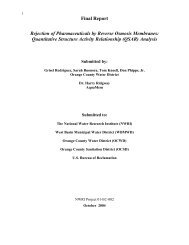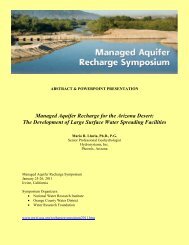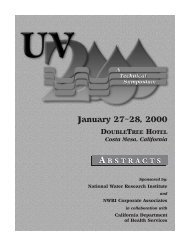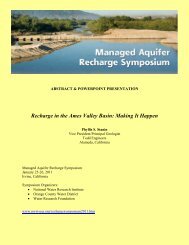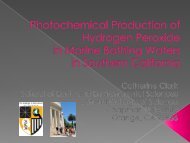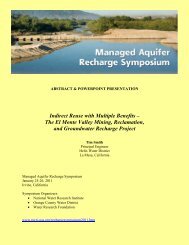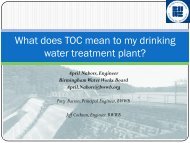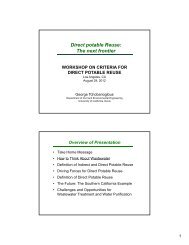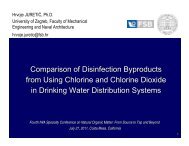RBF_Cover (for eps) - National Water Research Institute
RBF_Cover (for eps) - National Water Research Institute
RBF_Cover (for eps) - National Water Research Institute
You also want an ePaper? Increase the reach of your titles
YUMPU automatically turns print PDFs into web optimized ePapers that Google loves.
32<br />
contaminants from the river to the wells. Additionally, Iowa regulatory officials issued a preliminary<br />
determination that the newly constructed collector wells were groundwater under the direct<br />
influence of surface water (GWUDI) sources.<br />
To date, major study activities and work products of the USGS/Cedar Rapids <strong>Water</strong> Department<br />
cooperative study include:<br />
• Identification and mapping of contaminant sources in the immediate vicinity of the<br />
City’s wells.<br />
• Development of a regional groundwater model covering 231 square miles, which<br />
simulates groundwater flow under steady-state conditions.<br />
• Construction of a detailed groundwater flow model, which simulates groundwater flow<br />
and well recharge under transient conditions (a computer model is now complete and<br />
being tested).<br />
• Completion of extensive water-quality monitoring (physical and chemical parameters) of<br />
the river and wells.<br />
This research, along with the Cedar Rapids <strong>Water</strong> Department’s Source <strong>Water</strong> Assessment study,<br />
has documented the importance of the river and the potential contaminant threats it poses to our<br />
water supplies. They have also confirmed the protection and other benefits af<strong>for</strong>ded by <strong>RBF</strong>.<br />
Consequently, the cooperative study was recently expanded to include the entire Cedar River<br />
<strong>Water</strong>shed. The Cedar Rapids <strong>Water</strong> Department, USGS, and Iowa Geological Survey Bureau<br />
have partnered to conduct three separate comprehensive synoptic studies of water quality of<br />
samples at 64 locations throughout the watershed. A dye tracer/time-of-travel study has been<br />
completed on the lower main stem of the Cedar River, with plans <strong>for</strong> more dye tracing on other<br />
sections at low flow conditions, as well as possible Lagrangian sampling. In Lagrangian sampling,<br />
the same mass of water is sampled as it moves downstream. The objective of this study will be to<br />
validate time-of-travel models and to determine the fate of nitrogen compounds as they are<br />
transported down the river (D.J. Schnoebelen, 2002).<br />
In summary, the Cedar Rapids <strong>Water</strong> Department has attempted to develop a better understanding<br />
of the river and its wells, which would allow the implementation of management and<br />
protection programs <strong>for</strong> its drinking-water supplies. Although we did not fully understand its role<br />
until just recently, <strong>RBF</strong> is a valuable pretreatment process and is an integral component of our<br />
multi-barrier strategy <strong>for</strong> protecting water quality. It has enabled the Cedar Rapids <strong>Water</strong><br />
Department to avoid any violations of the drinking-water standard <strong>for</strong> nitrate that would<br />
necessitate the construction and operation of costly nitrate removal facilities.<br />
Without <strong>RBF</strong>, the Cedar Rapids <strong>Water</strong> Department would not have been able to supply quality<br />
water that meets all drinking-water standards while maintaining the competitive rates required by<br />
its major customers, the local industries. Although very beneficial, it must be acknowledged that<br />
<strong>RBF</strong> does not completely remove contaminants, as evidenced by the presence of nitrates and<br />
herbicides in Cedar Rapids’ well supplies. <strong>RBF</strong>, along with watershed protection programs, must<br />
be a key element of Cedar Rapids’ multi-barrier approach to the protection of its water supplies<br />
and public health.



